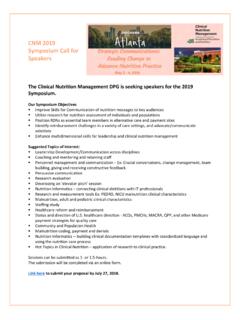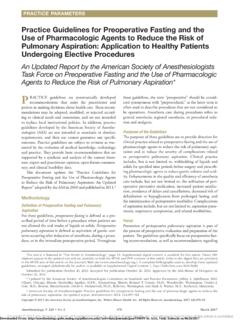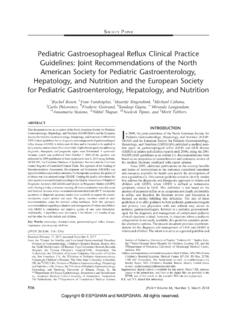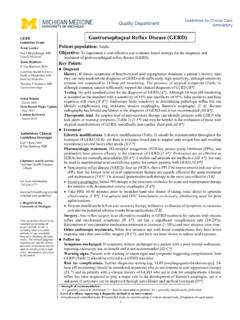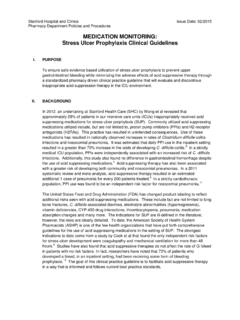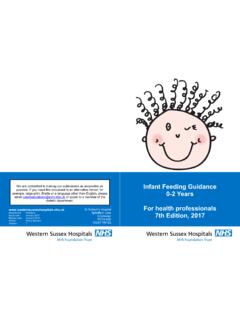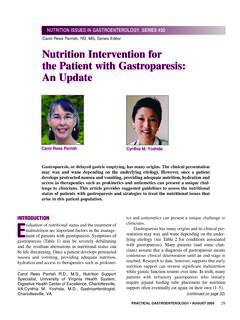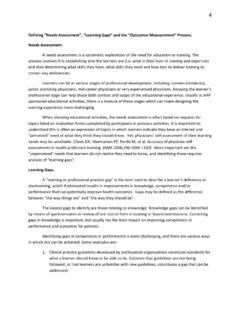Transcription of Post-Operative Feeding: Time to move on
1 Post-Operative Feeding: Time to move on Kate Willcutts, MS, RD, CNSC University of Virginia Health System April 2013 NPO OBJECTIVES Explain the history of post operative feeding. Explain the "Enhanced Recovery After Surgery" pathways and the dietitian's role. Briefly address benefits of shortening the duration of pre-operative fasting. Discuss research that supports early feeding after surgery. Explain evidence supporting swifter advancement to regular diet after surgery. Explain a process improvement project that resulted in the design of a new diet for postoperative patients.
2 EARLY POST-OP TUBE FEEDING Since the late 70 s early 80 s studies have been done that demonstrate early post operative tube feeding is safe. In some patient populations early EN has been reported to: reduce septic complications, wound infections, improve wound healing. Most benefit seen in burn, trauma, and surgical pts. More recently studies have shown the safety and benefit of early postoperative oral intake. Figure 3. Odds ratio (OR) for complications (nausea and vomiting excluded). Osland E et al. JPEN J Parenter Enteral Nutr 2011;35:473-487 Copyright by The American Society for Parenteral and Enteral Nutrition Figure 4.
3 Odds ratios (ORs) for mortality. Osland E et al. JPEN J Parenter Enteral Nutr 2011;35:473-487 Copyright by The American Society for Parenteral and Enteral Nutrition Figure 5. Odds ratios (ORs) for anastomotic leak. Osland E et al. JPEN J Parenter Enteral Nutr 2011;35:473-487 Copyright by The American Society for Parenteral and Enteral Nutrition Figure 7. Days to passing flatus. Osland E et al. JPEN J Parenter Enteral Nutr 2011;35:473-487 Copyright by The American Society for Parenteral and Enteral Nutrition Figure 8. Days to first bowel motion. Osland E et al. JPEN J Parenter Enteral Nutr 2011;35:473-487 Copyright by The American Society for Parenteral and Enteral Nutrition Figure 9.
4 Length of stay (days). Osland E et al. JPEN J Parenter Enteral Nutr 2011;35:473-487 Copyright by The American Society for Parenteral and Enteral Nutrition TRADITIONAL POST OP Fasting Patient involvement = passive Bedrest Fast Track = Enhanced Recovery After Surgery (ERAS) Originated in Europe. ERAS or modifications of it include up to 20 perioperative interventions1. Mostly in colorectal surgery patients. Also in gastrectomy1 , AAA repair2 , gynecologic, hepatocopancreatic3 , laryngectomy, urology. Use of protocols - earlier return of GI function and shorter LOS by 1-4 days.
5 Associated with reduction in length of hospital stay, readmissions, reoperations, improved pain control, improved patient satisfaction and less cost. Institutions slow to implement ERAS4. 2. Muehling 3. Balzono and Spelt 4. Delaney 2010 Length of Hospital Stay in Elective Colorectal Surgery - RCTs 0123456789 TraditionalEnhancedAdamina et al. Meta analysis Anderson et al UK, TC/14 ERPD elaney et al USA, TC/31 ERPGatt et al UK TC/19 ERPKhoo et al TC/35 ERPS erclova et al TC/51 ERPM uller et al TC/76 ERP0100020003000400050006000700080009000 10000 PreERASPostERASCost per pt Cost per ptincludingreadmission costsCost Differences between pre ERAS and post ERAS Stephen and Berger Surgery.
6 2003 Mar;133(3):277-82. Fearon et al. ENHANCED RECOVERY AFTER SURGERY (ERAS) INCLUDES: Preoperative patient education Pre-op carb solution Immediate removal of NGT Early food intake Chewing gum and laxatives Meds to prevent nausea and vomiting Limiting IV fluids given Oral nutritional supplements until discharge Immediate postoperative mobilization Fearon et al. Vlug et al 2011 WHAT ABOUT PREOPERATIVE FASTING? Tradition NPO after midnight. Anesthesia increases risk of pulmonary aspiration. Anesthesiology associations are recommending more liberal guidelines 1.
7 Allow clear liquids up to 2 hrs before surgery. Solids up to 6 hrs before surgery. Reduced preop hunger, thirst, anxiety2. 1. American Society of Anesthesiology and Soreide et al. 2. Brady et al. PRE-OP CARB LOADING Carbohydrate-containing IV fluids or oral liquids reported to reduce catabolic response to surgery1. Improved glycogen stores and insulin sensitivity postoperatively3. Does reduce thirst and anxiety3 Some studies tested carbohydrate and protein. g/100 mL carbohydrates 285 mOsm/kg 12% monosaccharides 12% disaccharides 76% polysaccharides (maltodextrins) 1.
8 Noblett et al. 2. Nygren et al 3. Kaska et al. HOW THIS THEORETICALLY WORKS Patient enters surgery in fasted or catabolic state. Glycogen stores are depleted. Fasting AND surgery cause increased stress hormones and cytokines which cause insulin resistance. Hyperglycemia - gluconeogenesis Protein breakdown increases Negative nitrogen balance Preoperative carbohydrate reduces period of fasting. Reduces loss of glycogen stores reducing catabolism. Reduces postoperative insulin resistance and levels of stress hormones and cytokines. Post-Operative NUTRITION Traditional approach NPO until return of bowel function Possibly leaving in NGT for decompression of the stomach.
9 After bowel function returns, remove NGT, start ice chips or clear liquid diet and then advance as tolerated . THIS IS WHY Concern about: Anastomotic breakdown and then fistulas or wound dehiscence due to distended bowel from increased volume from enteral nutrition and/or GI secretions. Or aspiration due to ileus and subsequent pneumonia. ILEUS Greek eileos intestinal colic from eilo = to roll tight Paralytic or adynamic ileus vs mechanical Characterized by: abdominal pain, distention No stool or flatus Emesis POST-OP ILEUS (POI)1 Transient cessation of coordinated bowel motility after surgical intervention, which prevents effective transit of intestinal contents or tolerance of oral intake 2 Primary POI not due to complications of surgery1.
10 Secondary POI due to infection, anastomotic leak, obstruction1. 1. Carroll et al. 2. Kehlet et al RETURN OF BOWEL FUNCTION1 After surgery and without feeding, motility usually returns within 6-12 hours in the small bowel 12-24 hours in the stomach 48-72 hours in the colon Prolonged POI > 3-5 days 2 RETURN OF BOWEL FUNCTION Presumed resolution of ileus often based on: Presence of bowel sounds Passage of flatus Bowel movements However, lack of bowel sounds, flatus or stool are not diagnostic for ileus. Neither the presence nor absence of bowel sounds and evidence of passing flatus or stool is needed prior to the initiation of EN.
